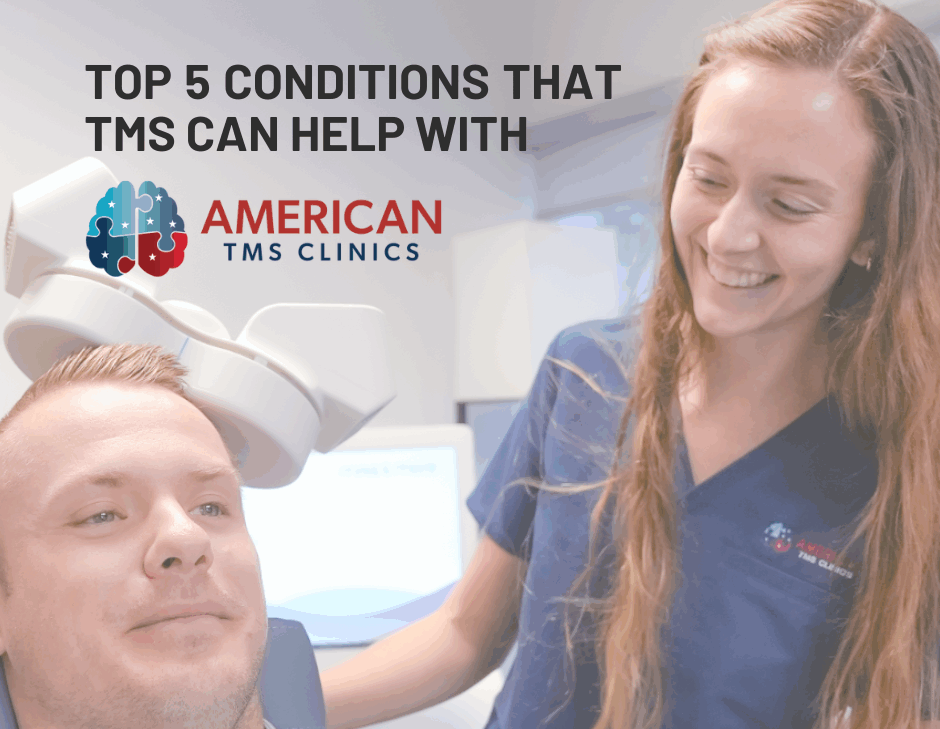When symptoms aren’t improving with medication and traditional therapies, many individuals living with mental health conditions seek out alternative, evidence-based treatments. One option people are increasingly turning to is Transcranial Magnetic Stimulation (TMS) therapy. What is TMS therapy? TMS therapy is a non-invasive procedure that uses magnetic fields to stimulate nerve cells in the brain.1 TMS therapy is approved by the FDA, backed by years of clinical research, and has helped many reclaim their lives when other treatment methods haven’t been effective.1
Here are the top 5 conditions that TMS therapy can help treat:
- Major Depressive Disorder (MDD)
TMS therapy is most widely known for its application in helping with treatment-resistant depression. While there are many effective treatment options, ranging from therapy to medications, as many as 30% of these depressed patients do not respond to treatment.2 Alternative therapy options, like TMS therapy, can be used in these patients with treatment resistant depression.2 A study conducted on treatment-resistent patients revealed that repetitive TMS therapy lead to a significant decrease in depression according to their ratings on the Hamilton Depression Rating Scale compared to their counterparts that did not receive TMS therapy.2
- Obsessive Compulsive Disorder (OCD)
The FDA has approved TMS therapy for OCD, a condition that affects millions with intrusive thoughts and repetitive behaviors. According to a study done on patients with OCD, compulsive urges showed a significant decrease after right lateral prefrontal repetitive TMS therapy.2 For those living with OCD that haven’t found relief from other treatment methods or are experiencing negative side effects, TMS therapy is a safe, clinically-backed solution worth exploring.
- Anxiety Disorders
TMS is increasingly being used to help manage generalized anxiety disorder (GAD) and panic disorder, especially when anxiety coexists with depression. Most studies have used the stimulation region in the right dorsolateral prefrontal cortex as a means to treat anxiety using TMS therapy.3 Studies have shown that TMS therapy intervention had positive effects on anxiety symptoms.3 While improvement has been shown in limited studies, research is still ongoing to fully understand how TMS therapy can impact patients with anxiety. TMS therapy for anxiety is not currently approved by the FDA, but can offer an option for those where alternative anxiety treatment methods have failed.
- Post-Traumatic Stress Disorder (PTSD)
A study of ten patients with PTSD showed that just one session of TMS therapy was found to be effective in lowering the primary symptom of PTSD, including, avoidance, anxiety, and somatization.2 The patients also showed general improvement according to measurement on the Clinical Global Impression Scale.2 Repeated sessions of TMS therapy showed better outcomes for the longevity of symptom relief.2
- Attention Deficit Hyperactivity Disorder (ADHD)
Many turn to medication in order to treat ADHD, however, 10 to 30 percent of patients do not respond to the conventional pharmacotherapy, and untoward adverse effects and potential for abuse can restrict the use in others.4 Considering the research that has shown TMS therapy’s benefits for medication resistant patients with conditions like MDD, its potential to help with conditions like ADHD has generated increased attention.4 TMS uses magnetic fields to stimulate specific brain areas, potentially impacting neural pathways associated with ADHD symptoms. While TMS is not yet FDA-approved specifically for ADHD, its use in this area is growing quickly in research and practice. For individuals looking for alternatives to medication or who haven’t found success with traditional ADHD treatments, TMS could offer a new path forward.
If you’re living with a mental health condition that hasn’t improved with traditional treatment, American TMS Clinics, located in Scottsdale, Arizona, is here to help. Our compassionate providers offer personalized TMS therapy plans based on your unique needs, with the goal of restoring balance and hope.
References
1.Mayo Clinic. (2023, April 7). Transcranial magnetic stimulation. Mayo Clinic. Retrieved July 15, 2025, from https://www.mayoclinic.org/tests-procedures/transcranial-magnetic-stimulation/about/pac-20384625
2.Basil, B., Mahmud, J., Mathews, M., Rodriguez, C., & Adetunji, B. (2005). Is there evidence for effectiveness of transcranial magnetic stimulation in the treatment of psychiatric disorders?. Psychiatry (Edgmont (Pa. : Township)), 2(11), 64–69.
3. Rodrigues, P. A., Zaninotto, A. L., Neville, I. S., Hayashi, C. Y., Brunoni, A. R., Teixeira, M. J., & Paiva, W. S. (2019). Transcranial magnetic stimulation for the treatment of anxiety disorder. Neuropsychiatric disease and treatment, 15, 2743–2761. https://doi.org/10.2147/NDT.S201407
4.Memon A. M. (2021). Transcranial Magnetic Stimulation in Treatment of Adolescent Attention Deficit/Hyperactivity Disorder: A Narrative Review of Literature. Innovations in clinical neuroscience, 18(1-3), 43–46.

